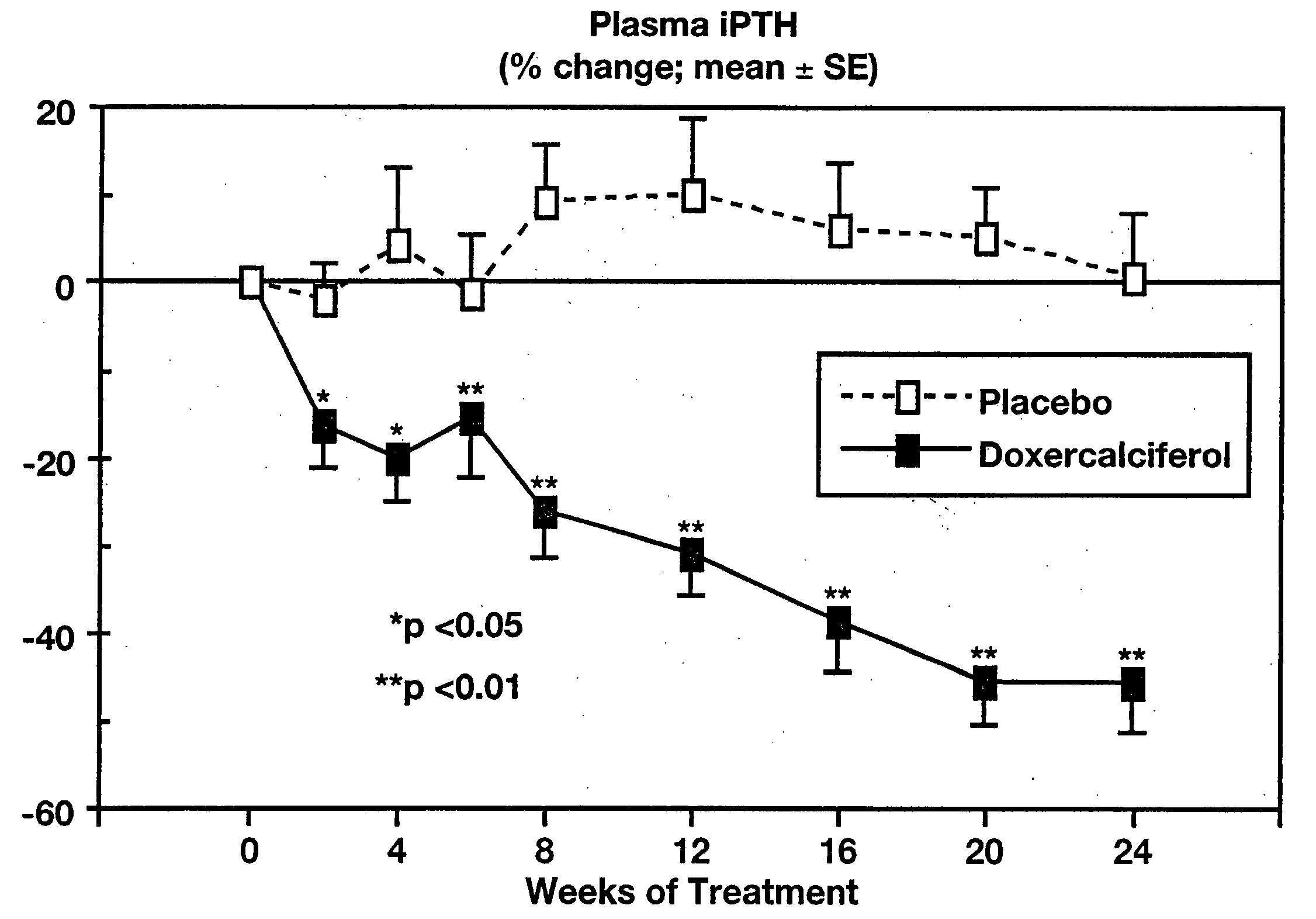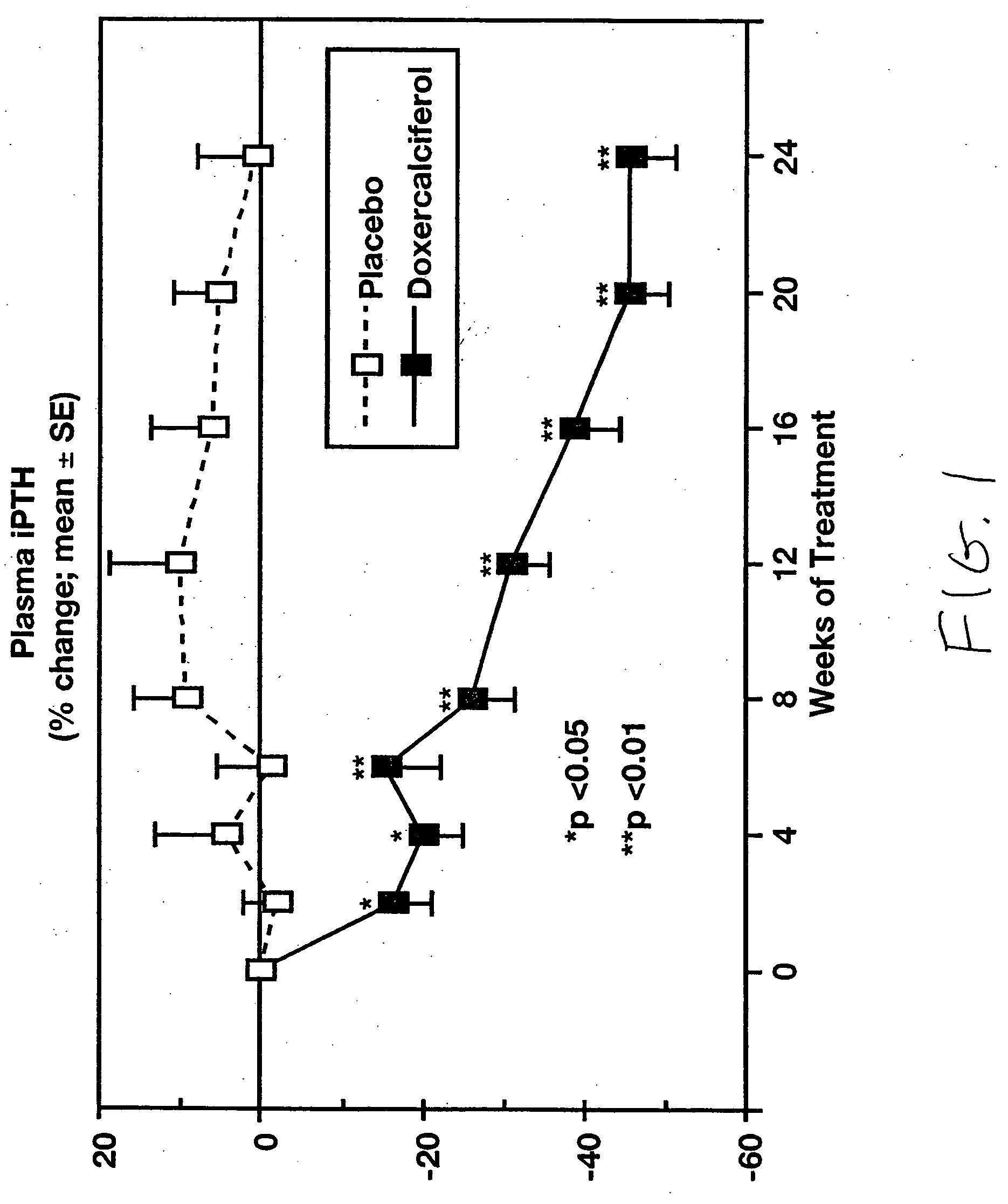Methods of treating various vitamin D metabolism conditions with 1alpha-hydroxyvitamin D2
a technology of alpha-hydroxyvitamin d2 and metabolism conditions, which is applied in the field of treating various vitamin d metabolism conditions with alpha-hydroxyvitamin d2, can solve the problems of inability to produce 1, progressive loss of kidney function or complications, and decrease in the ability of vitamin d to be absorbed from the intestine, so as to increase or maintain blood concentrations and increase the risk of hypercalcemia
- Summary
- Abstract
- Description
- Claims
- Application Information
AI Technical Summary
Benefits of technology
Problems solved by technology
Method used
Image
Examples
example 1
Use of 1α-hydroxyvitamin D2 for Treating Human Osteoporosis
[0047] 1α-(OH)D2 was used to treat osteoporosis was confirmed in a study involving 60 postmenopausal osteoporotic outpatients. The selected subjects had ages between 60 and 70 years, and exhibited L2-L3 vertebral BMD between 0.7 and 1.05 g / cm2, as determined by dual-energy x-ray absorptiometry (DEXA). Exclusion criteria encompassed significant medical disorders and recent use of medications known to affect bone or calcium metabolism.
[0048] On admission to the study, each subject was assigned at random to one of two treatment groups; one group received up to a 104-week course of therapy with 1α-(OH)D2; the other received only placebo therapy. All subjects received instruction on selecting a daily diet containing 700-900 mg of calcium and were advised to adhere to this diet over the course of the study. Compliance to the diet was verified at regular intervals by 24-hour food records and by interviews with each subject.
[0049...
example 2
1α-hydroxyvitamin D2 for Treating Subjects with Chronic Kidney Disease with Elevated Blood PTH
[0062] 1α-(OH)D2 (doxercalciferol) was used as a treatment for hyperparathyroidism associated with chronic kidney disease was confirmed in a study involving 55 adults, ages 18-85 years, with mild to moderate chronic kidney disease. The subjects had plasma intact parathyroid hormone (iPTH) levels above 85 pg / mL and completed an eight-week baseline period and then 24 weeks of therapy with either orally administered doxercalciferol or placebo.
[0063] The initial dose of test drug was 2 capsules daily (totaling 1.0 μg for subjects randomized to doxercalciferol treatment), with increases in steps of one capsule per day permitted after four weeks. The maximum dosage was limited to 10 capsules per day (5.0 μg / day of doxercalciferol). Subjects were monitored at regular intervals for plasma iPTH, serum calcium and phosphorus, 24-hour and fasting urinary calcium, bone-specific serum markers, plasma ...
example 3
1α-hydroxyvitamin D2 for Treating Subjects with Low Serum Calcium
[0097] 1α-(OH)D2 (doxercalciferol) is used as a treatment for subjects with low serum calcium in a study involving 50 adults, ages 18-85 years.
[0098] The subjects have serum calcium levels below 8.6 mg / dL and complete an eight-week baseline period and then 24 weeks of therapy with orally administered doxercalciferol.
[0099] The initial dose of 1α-(OH)D2 is 2 capsules daily (totaling 1.0 μg), with increases in steps of one capsule per day permitted after four weeks. The maximum dosage is limited to 10 capsules per day (5.0 μg / day of doxercalciferol). Subjects are monitored at regular intervals for plasma iPTH, serum calcium and phosphorus, 24-hour and fasting urinary calcium, bone-specific serum markers, plasma total 1α,25-(OH)2D, and routine blood chemistries and hematologies.
[0100] After the 24 week treatment period the subjects treated with 1α-(OH)D2 show average serum phosphorous levels between about 2.4-5 mg / dL,...
PUM
 Login to View More
Login to View More Abstract
Description
Claims
Application Information
 Login to View More
Login to View More - R&D
- Intellectual Property
- Life Sciences
- Materials
- Tech Scout
- Unparalleled Data Quality
- Higher Quality Content
- 60% Fewer Hallucinations
Browse by: Latest US Patents, China's latest patents, Technical Efficacy Thesaurus, Application Domain, Technology Topic, Popular Technical Reports.
© 2025 PatSnap. All rights reserved.Legal|Privacy policy|Modern Slavery Act Transparency Statement|Sitemap|About US| Contact US: help@patsnap.com



